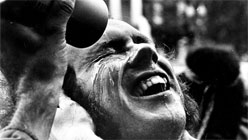Jesse Pollock has many irons in the fire. Under the umbrella of his Unpiano label, he runs a music blog and publishes art books. He is a fixture on the art scene, showing his photos in galleries, making zines, and playing music. His varied interests all come down to sharing. He likes, simply, “putting things in people’s hands and watching them freak out about it.” We recently sat down in KQED’s green room to talk about Unpiano’s latest release, a substantial black-and-white photo book featuring the work of Arthur Pollock, a long-time photojournalist for the Boston Herald, and Jesse’s dad.
The project began in the Pollock family basement. “I went through a thousand photos and 900 made my jaw drop. That’s just the kind of photographer he is.” Jesse first made a zine of the work, then showed some of the photos with Hamburger Eyes, sensing that his dad’s work fit in with their street photography aesthetic. But it was difficult to explain what that meant. “I’m still not certain my dad knows what Hamburger Eyes is. I’ve tried to explain it, but it’s a hard concept to understand when you’re a certain age and you’re far away.”

Jesse took the work a step further by publishing a book in which each of Arthur Pollock’s photos has a subtle dialogue with the next, and each one screams a story. “Everything is put together for a reason, whether thematically or aesthetically. I tried to go chronologically and snake my way through his career from the ’60s to the ’80s. Within that timeline, I tried to go with other sub-themes like crime or love.”
Through the photos, Pollock could better understand his dad’s experiences shooting for the press. “Early on he was involved in the unrest of the ’60s and ’70s and a lot of collegiate protests at Kent State. Protests are another theme in the book. He was deep in a lot of those movements, but I don’t think he was the guy to stand in front of the cop and spit in their face, he’d be the guy behind the camera taking the photo of it. That’s the way he found to be involved, which is something I relate to. It’s better than not being involved at all.”




